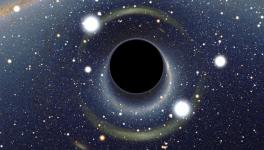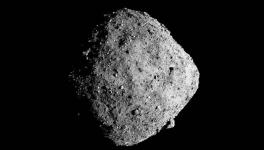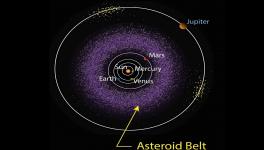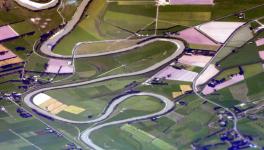Arsenic Eating Bacteria or Is California a Weird Place?
So why is there a huge ruckus over an arsenic eating bacteria in Lake Mono, California? Not only the scientific world but the world's media has been an uproar over ever since Felisa Wolfe-Simon and her colleagues reported in Science online (Wolfe-Simon, F. et al. Science 2010) of a novel bacteria that appears to substitute phosphorous with arsenic in its DNA chain. By itself, this is an astonishing result as phosphorous is one of the six elements in the DNA chain which are considered as absolutely irreplaceable. NASA hyped this up even more, claiming that this could be a proof that extra-terrestrial life is much more likely than thought earlier. If one element out of the essential six can be shown to replaceable, why not others? Why not a silicon-based life form instead of a carbon-based one, the staple of science fiction and Star Trek?
A new life form or a weird bug?
The scientific community was quick to react – and in what is being termed as post peer review. They criticised the paper for shoddy science and tore into many of the arguments advanced in the paper. Science (June, 2011) recently published 8 critiques of the paper along with the response of the original authors. The majority view of scientists is that the study is deeply flawed and the conclusions not based on enough evidence. Extraordinary claims require extraordinary evidence; here the evidence was not not even ordinary. It was shoddy. The consensus view now is that the case for an arsenic based life form is far from proven, with the authors conceding in their response that their explanation of the results is “viable”, a far cry indeed from proven.
If NASA had not got into the act even before the paper was published in Science, the paper may have drawn attention in the scientific circles, but not in the popular media. NASA linked it to the possibility of extra-terrestrial (ET) life forms and set the media ablaze. In fact, in the teaser for the press conference announcing the paper, they even talked of finding proof of such extra-terrestrial life forms. Not many were expecting this press conference to be about only a weird bug in a lake in California.
Why did NASA act the way that they did? Some believe that NASA desperately needs a boost in public perception if its funds are not to be cut. The exobiology section needs it even more, as the scope of finding life forms outside earth is indeed difficult. All it can look at is some soil samples from moon and Mars, apart from meteorites, which are heavily contaminated travelling through earth's atmosphere in the last leg of their journey. NASA took the easier route of finding novel life forms in strange and exotic environment, but all on earth. Not surprisingly, California is the number one in the list of weird places on earth – does it not have an ex-Terminator who ended up being a Governor of the state?
Lake Mono, which is where the search for ET was being conducted, is a lake that has 3 times the salt content of sea water and with a high concentration of arsenic. Any bacteria growing in such an environment in any case is not normal. What Felisa Wolfe-Simon, currently a NASA astrobiology research fellow and her colleagues in the US Geological Survey Institute in Menlo Park did, was to take out phosphorus from the nutrient medium of Lake Mono and put the bacteria strain GFAJ-1 in it. Their claim was that the bacteria not only survived but actually grew in this medium, leading to the belief that it had successfully substituted arsenic for phosphorous.
Why is substituting arsenic with phosphorous such a big thing? All life form on earth has six elements -- carbon, hydrogen, oxygen and nitrogen are the most common, followed by phosphorus, then sulphur. If we remember the double helix of the DNA, it has rungs which clamp off to the sides of the DNA ladder. The sides of the DNA ladder, referred to as its backbone, are long chains of alternating sugar and phosphate molecules. Therefore no phosphorus, no backbone and no DNA. Ergo, no phosphorus, no life.
The critics have pointed out that there were traces of phosphorous in the medium and therefore all that the research team has shown is that the bacteria GFAJ-1 can survive under very adverse conditions. It may store arsenic but there is no evidence to support it uses arsenic in the DNA chain to supplant phosphorous. It is merely another member in a set of bacteria called extremophiles , bacteria that can survive in extreme environments -- highly acidic medium, under high temperature and so on. It is not a new life form nor does it prove that life can arise using other elements in a different way than life on earth.
If the issue was only a scientific one of whether arsenic can substitute for phosphorus or not, it would have remained in dry-as-dust academic journals. However important or startling that it may have been in science, NASA's exobiology claim brought it into lime light, creating the media blitz. The authors no doubt played it up, with their press conference even before the paper was formally published in Science. Felisa went on to give a TED lecture and even appeared in Glamour magazine (June 2011) with her “Four Laws of getting people to believe in you”. Retrospectively, it is this exobiology claim that has created a back-lash.
Media and Science
The two other important issues are not about what science is being done but about how science is being done. This is one example where the scientific community thought that the issue was important enough for it to spill over from journals to twitter and the blogosphere. A major part of the discussion including critiques were conducted publicly over the Internet and Twitter, and not in journals, academic seminars and workshops. This is relatively new and not how science is usually done or how scientists would like to claim that science is actually done. Felisa and her colleagues even went as far as to say that they would not respond to all the criticism in the blogospehere and the media and would confine their response to only scientific journals. Their rushing into the media themselves and even into magazines like Glamour certainly did not help their case.
The controversy also provided lighter moments. An anonymous wit used the Twitter handle @arsenicmicrobes to send the following tweet shortly after the first news broke: "We come in peace." Others have renamed GFAJ-1 as “Give Felisa a Job”. It has certainly added humour and glamour to the otherwise inaccessible papers that scientists publish. And everyone loves a big fight, even if they do not understand what it is all about, arsenic or no arsenic.
The problem today is that science is not done the way people claim science is done. Making startling claims to the media is becoming much more the norm than the exception. It helps careers and grants to appear on TV and the media. If the claims are unfounded – as the arsenic eating bacteria may well be-- it does back-fire. Scientists are willing to take this risk today. If scientific claims are made in the media, it is not surprising that the scientific response will also be public. With Internet, blogs and Twitter, it is obvious the old ways of conducting scientific discussions will give way to a much more public ones including social networking sites.
How Self-correcting is Science?
The second important issue is an even more fundamental one – how self-correcting is science? Carl Zimmer in an important article (June 25, 2011, has pointed out that science is not as self-correcting) as it is claimed. He has used the arsenic controversy to show that though it would be comparatively easy to repeat the experiments and disprove the results of Felisa and her team, no serious scientist would actually do this. This is simply because no serious science journal publishes what are called replication studies or negative findings. Therefore, even if a researcher took the time and trouble to disprove Felisa and co's research, this would not give them any academic brownie points.
It is this approach to science where only positive results are published that makes science appear a very different enterprise than it actually is. In life, science is largely walking down paths that yield no results. This is something that nobody would conclude if he or she looked at the plethora of results in the scientific journals. More important, it allows known dead-ends in science to remain as apparently fruitful paths, as results showing it to be dead-end are not published, while a number of past publications may indicate it to be a productive one.
If we take the current controversy, none of the eight who had critiqued the arsenic result in Science have actually tried to replicate it. Zimmer points out, “That would take months of research: getting the bacteria from the original team of scientists, rearing them, setting up the experiment, gathering results and interpreting them. Many scientists are leery of spending so much time on what they consider a foregone conclusion, and graduate students are reluctant because they want their first experiments to make a big splash, not confirm what everyone already suspects.”
Zimmer has also written about another case, “Daryl Bem, a psychologist at Cornell University, shocked his colleagues by publishing a paper in a leading scientific journal, The Journal of Personality and Social Psychology, in which he presented the results of experiments showing, he claimed, that people’s minds could be influenced by events in the future, as if they were clairvoyant”.
However, when other scientists submitted a paper showing that their experiments failed to show any such phenomenon, the Journal concerned refused to publish it, saying it did not as a policy, publish replication results. The original paper therefore still stands.
The problem in science, particularly in third world science is even worse. Our living contact with word of mouth negative results are limited. We depend much more on published results in known journals. If such results are faulty, it may widely known amongst the leading researchers. However, a student in a far away lab could lose years of effort to come up with nothing after trying to build on such results. Even worse, the failure to find anything useful would not get him or her either a paper or a Ph.D. This would truly be useless labour, all because the journal in question does not have a policy of retracting known wrong results. Nor does science have a policy which gives value to negative findings.
If science truly has to be a self-correcting process, it needs to be put much more value and money into replication studies and negative findings. Without this, the self-correction in science would take place – but over a much longer time frame and with enormous hidden waste.
Photograph Countesy: dimland.blogspot.com
Get the latest reports & analysis with people's perspective on Protests, movements & deep analytical videos, discussions of the current affairs in your Telegram app. Subscribe to NewsClick's Telegram channel & get Real-Time updates on stories, as they get published on our website.






















